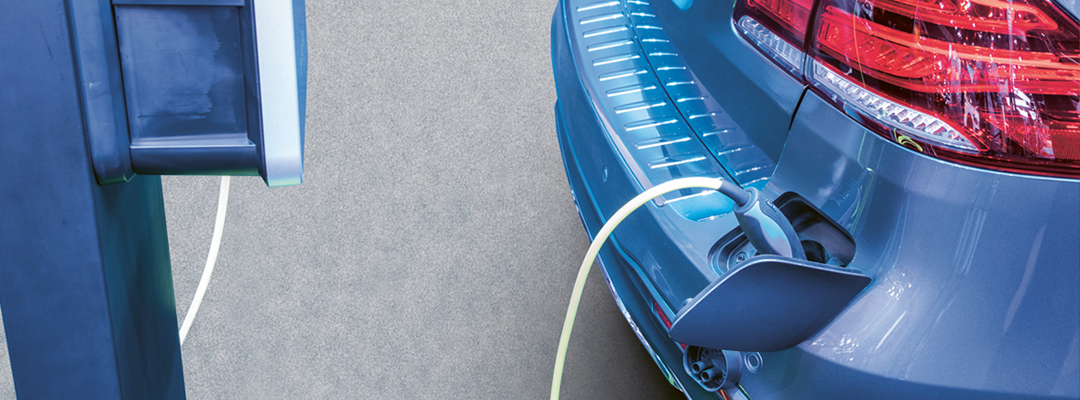
Annual Report 2020
FOREIGN OBJECT DETECTED – DANGER AVOIDED

New production processes for e-vehicles bring new safety risks. An innovative solution from SICK reduces the risk of damage to drive batteries.
Our mobility is in turmoil – e-vehicles are gaining in importance. This also affects the industry: Carmakers must establish new, highly automated production processes. These, however, involve serious new safety risks for humans and the environment, and appropriate solutions are required.
SMALL FOREIGN BODIES WITH MAJOR CONSEQUENCES
One example of this need for new solutions is the high-voltage lithium-ion batteries used in e-vehicles: The battery housing can be damaged if a foreign body is located on it during connection of the battery to the chassis on the production line. This could cause a perforation of the battery housing, a shortcircuit, and an increased risk of fire. Such fires are dangerous, difficult to extinguish, and cause enormous financial harm. A perforation of the battery housing is also problematic later, during operation of the vehicle. In the worst case, liquid could penetrate the battery and trigger a fire. A variety of carmakers have already had to carry out complicated and expensive product recalls – and not just because of these risks.
An innovative solution from SICK now provides help: Before the battery is connected to the chassis, it is scanned by several autonomous inspection heads and up to eight Ranger3 3D streaming cameras in an inspection cell. This reliably detects foreign bodies at maximum speed and with extreme accuracy.
HIGH-PRESSURE DEVELOPMENT OF THE OPTIMUM SOLUTION FOR CUSTOMERS
In 2020, SICK received an order from a supplier to a major German carmaker to create an application for a new production line. As it turned out this was a project that proved difficult in many ways: “There were only a few weeks between the order and the desired commissioning date,” says Simon Uhl, Technical Project Manager Solution Engineering & Integration. And that was not all: The task was also complicated because the high-tech production line was very complex. And there was another challenge: “New components – about which neither the customer nor SICK had much more than technical drawings – were planned for this application,” says Simon Uhl.
The development team at SICK Vertriebs-GmbH, which maintains close contact with customers, worked out the solution: It develops individual solutions for customers based on SICK components, the SICK AppSpace software framework, and the team’s high level of engineering knowledge. In this difficult situation, the start of the coronavirus crisis further complicated the team’s work: “In the middle of lockdown we could only seldom meet the customer personally or get together with the whole development team. From the initial discussions, through the proof-of-concept stage and test setup, to training for users of the plant, most of the communication took place via video conferencing,” says Simon Uhl. “Although we sorely missed the personal contact, the good collaboration with the sales and development team as well as with the support departments in the background ensured that the inspection cell went into operation on time and to the great satisfaction of the customer.”
INDIVIDUAL SOLUTIONS, INTERNATIONALLY AVAILABLE
The system is meanwhile in demand at SICK from a variety of carmakers and plant constructors worldwide. The company is thus consolidating internal strengths and working on standardization so that the solution can be made available internationally. But how can one create customized solutions efficiently with such clear country-specific differences regarding car designs and production lines? “Firstly, we use as many standard components as possible,” explains Uhl. “We also developed a system portfolio that was as diverse as possible and could cope with numerous battery types. We can now cover all potential enquiries using this solution portfolio – which consists of one core, one prime, and one Pro solution.” The engineering team can also rapidly adapt the system to individual customer requirements by means of supplementary hardware, application-specific programming in the SICK AppSpace, and individualized engineering: “Our advantage is that, as a solution supplier, we can deliver the hardware, software and commissioning work as a turnkey solution. This enables the team to respond to customer requirements with maximum flexibility,” according to Uhl.
An anecdote from this project shows the importance of this flexibility at SICK and the possibilities it opens up: The customer asked whether the system could also detect whether something was missing or not – for example, one of the preinstalled screws that connects the batteries to the chassis. A missing screw would result in insufficient stability, another safety-relevant aspect. SICK had the solution: “We were able to integrate this function in our system at a fraction of the price that it would have cost as a stand-alone solution,” says Oliver Czapla, Manager of Image Processing Solutions, SICK Vetriebs GmbH.
SICK believes that there will be a general rise in demand for quality inspection applications and an increasing need to minimize safety risks for e-vehicle production plants: “The sector is highly dynamic, and many innovations are expected in the future – not just regarding batteries. This example underlines the importance of sensor solutions in the changing production conditions facing carmakers. Customized solutions from SICK will, in future, be an important element in vehicle production,” says Czapla. So this field offers great potential for SICK.







